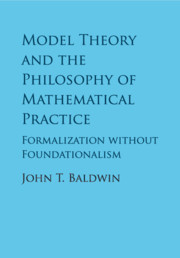Book contents
- Frontmatter
- Dedication
- Contents
- List of Figures
- Acknowledgments
- Introduction
- PART I REFINING THE NOTION OF CATEGORICITY
- PART II THE PARADIGM SHIFT
- 4 What Was Model Theory About?
- 5 What Is Contemporary Model Theory About?
- 6 Isolating Tame Mathematics
- 7 Infinitary Logic
- 8 Model Theory and Set Theory
- PART III GEOMETRY
- PART IV METHODOLOGY
- References
- Index
6 - Isolating Tame Mathematics
from PART II - THE PARADIGM SHIFT
Published online by Cambridge University Press: 19 January 2018
- Frontmatter
- Dedication
- Contents
- List of Figures
- Acknowledgments
- Introduction
- PART I REFINING THE NOTION OF CATEGORICITY
- PART II THE PARADIGM SHIFT
- 4 What Was Model Theory About?
- 5 What Is Contemporary Model Theory About?
- 6 Isolating Tame Mathematics
- 7 Infinitary Logic
- 8 Model Theory and Set Theory
- PART III GEOMETRY
- PART IV METHODOLOGY
- References
- Index
Summary
Martin Davis wrote,
Gödel showed us that the wild infinite could not really be separated from the tame mathematical world where most mathematicians may prefer to pitch their tents.
We will now see howmodernmodel theory avoids the Gödel phenomena; the key is to formalize topics locally by axioms which catch the relevant data but avoid accidentally encoding arithmetic and, more generally, pairing functions. We do not attempt a general definition of tame but provide a number of examples of sufficient model theoretic conditions. For more details, see page 160 and [Teissier 1997].
The most basic examples are when mathematicians are already studying definable relations on a class of structures and the natural axiomatization of the area yields a tame theory. In studying real or complex algebraic geometry, the formalization is automatic; Steinitz (ACF) and Artin-Schreier (RCF) defined concepts that happen to be first order; these theories provide the framework for much of the development of the geometries. The theories are ℵ1-categorical (Chapter 3.3; indeed, interpretable in a strongly minimal structure, Example 4.3.1) and o-minimal (Chapter 6.3), respectively.
One of the earliest algebraic discoveries linking algebraic structure with stability properties echoes the Bourbaki assertion of the importance of groups. An ω-stable group cannot have a descending chain of ‘definable subgroups’. This condition extends to stable groups (for uniformly definable chains) and the distinction between the stability classes is signaled by the size of the allowed quotient groups. This principle is now seen to apply to different algebraic structures and gives a unified explanation for finding various kinds of radicals.5 (See [Baldwin 1979] for a very early account of this phenomenon and [Altinel & Baginski 2014], [Aldama 2013], and [Freitag 2015] for recent updates.)
Groups of FiniteMorley Rank
In this section we give a short case study of one research area that serves both as a tool for unifying studies in several areas of mathematics and for isolating the role of basic concepts. In particular, it is seen that finite plays a dual role in the study of finite groups: both as the size of structure and as a dimension on which one can do inductions. In the case at hand, the study is extended to infinite groups by introducing a broader definition of ‘dimension’, Morley rank (Chapter 5.3), and requiring it to be finite.
- Type
- Chapter
- Information
- Model Theory and the Philosophy of Mathematical PracticeFormalization without Foundationalism, pp. 148 - 166Publisher: Cambridge University PressPrint publication year: 2018



